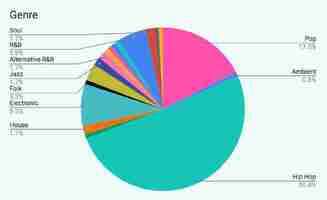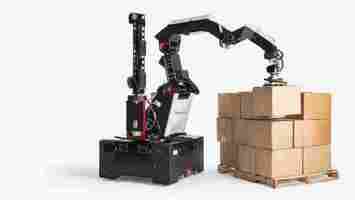This AI crunched the numbers to make the perfect TikTok song — but is it though?
TikTok may be on the verge of a US ban , but the app‘s content creators are still bravely pursuing their dreams of dancing mediocrely to vacuous music.

They all need a hit song to make their videos go viral. But it’s hard to work out which ear-piercing track will capture the audience their talent so richly deserves.
Stepping up to help is AI startup Musiio , which recently used its music analysis tools to craft the perfect TikTok hit.
Musiio first took the top 120 songs on the TikTok Trending playlist of 18 May 2020. It then ran the tracks through a metadata tagging system to identify the musical elements that make a video viral.
The system discovered that half of all TikTok hits were hip hop, which made it the obvious choice of genre for Musiio’s song.


The AI also spotted that most of the top TikTok songs were between either 60 to 80 bpm or 105 to 130 bpm. This convinced Musioo’s songwriters to use a similar tempo for their track.
Finally, the system revealed TikTok’s most popular musical moods. It recommended creating a “powerful,” “energetic,” or “quirky” track, and avoiding negative vibes such as “sadness,” “neutral,” or “scary.”
A songwriter called Brittle Bear then got to work on producing their track.
To keep things simple, he decided to focus entirely on the beat. First, he needed a melody that was “quirky” enough to stand out in the crowd of generic hip hop beats.
Keen to respect hip hop’s creed of representing your culture, Brittle Bear wanted a sample from Musiio’s native Southeast Asia. He plumped for a slice of gamelan, an Indonesian genre of instrumental music.
He then added “power” to the rhythm by combining a distorted bass drum from an 808 drum machine with some harsh hi-hats and snares.
Next, he blended all the elements into a final track. Musiio then ran the song through their AI to check if it fulfilled their ambitions.
The system gave the track a healthy 41% hip hop rating, an encouraging mood combination of 64% quirky and 41% powerful, and a decent emotion score of 33% positive.
However, the song’s 86 BPM was slightly beyond the optimal range, and its medium energy level was rather disappointing. But those issues can be easily fixed by dialing up the tempo and adding an angry rapper.
But could the song deliver 15 seconds of fame? You can judge that for yourself:
The track isn’t likely to bag a Grammy, but it sounds sufficiently vapid and raucous to attract the ears of TikTok teenyboppers.
If you catch you catch Charli d’Amelio throwing shapes to a gamelan banger, remember where you heard it first.
So you’re interested in AI? Then join our online event, TNW2020 , where you’ll hear how artificial intelligence is transforming industries and businesses.
Boston Dynamics’ latest robot doesn’t do backflips — and that’s a smart move
Boston Dynamics has made a name for itself through fascinating videos of biped and quadruped robots doing backflips, opening doors, and dancing to Uptown Funk. Now, it has revealed its latest gadget: A robot that looks like a huge overhead projector on wheels.

It’s called Stretch, it doesn’t do backflips, it doesn’t dance, and it’s made to do one task: moving boxes. It sounds pretty boring.
But this could, in fact, become the most successful commercial product of Boston Dynamics and turn it into a profitable company.
What does Stretch do?
Stretch has a box-like base with a set of wheels that can move in all directions. On top of the base are a large robotic arm and a perception mast. The robotic arm has seven degrees of freedom and a suction pad array that can grab and lift boxes. The perception mast uses computer vision–powered cameras and sensors to analyze its surroundings.
While we have yet to see Stretch in action, according to information Boston Dynamics provided to the media, it can handle boxes weighing up to 23 kilograms, it can make 800 displacements per hour, and it has a battery that can last eight hours. The video posted by Boston Dynamics on its YouTube channel suggests that the robot can reach the 800-cases-per-hour speed if everything remains static in its environment.
Traditional industrial robots must be installed in a fixed location, which puts severe limits on the workflows and infrastructure of the warehouses where they are deployed. Stretch, on the other hand, is mobile and can be used in many different settings with little prerequisite beyond a flat ground and a little bit of training (we still don’t know how the training works). This could be a boon for many warehouses that don’t have automation equipment and infrastructure.
As Boston Dynamics’ VP of business development Michael Perry told The Verge , “You can take this capability and you can move it into the back of the truck, you can move it into aisles, you can move it next to your conveyors. It all depends what the problem of the day is.”
A boring but useful robot
At first glance Stretch seems like a step back from the previous robots Boston Dynamics has created. It can’t navigate uneven terrain, climb stairs, jump on surfaces, open doors, and handle objects in complicated ways.
It did manage to do some amusing feats on its intro video, but we can’t expect it to be as entertaining as Spot, Atlas, and Handle.
But that’s exactly what real-world applications of robotics and artificial intelligence are all about. We still haven’t figured out how to create artificial general intelligence , the kind of AI that can mimic all aspects of the cognitive and physical abilities of humans and animals.
Current AI systems are robust when performing narrow tasks in stable environments but start to break when they’re forced to tackle various problems in unpredictable settings. Therefore, the success of AI systems is to find the right balance between versatility and robustness, especially in physical settings where safety and material damage are major concerns.
And Stretch exactly fits that description. It does a very specific task (picking up and displacing boxes) in a predictable environment (flat surfaces in warehouses).
Stretch might sound boring in comparison to the other things that Boston Dynamics has done in the past. But if it lives up to its promise, it can directly result in reduced costs and improved production for many warehouses, which makes it a viable business model and product.
As Boston Dynamics’ vice president of business development Michael Perry told The Verge last June, “[A] lot of the most interesting stuff from a business perspective are things that people would find boring, like enabling the robot to read analogue gauges in an industrial facility. That’s not something that will set the internet on fire, but it’s transformative for a lot of businesses.”
Boston Dynamics is not alone in working on autonomous mobile robots for warehouses and other industrial settings. There are dozens of companies competing in the field, ranging from longstanding companies such as Honeywell to startups such as Fetch Robotics.
And unloading boxes is just one of the several physical tasks that are ripe for automation. There’s also a growing market for sorting robots, order-picking robots, and autonomous forklifts .
What would make Boston Dynamics a successful contender in this competitive market? The way I see it, success in the industrial autonomous mobile robots market will be defined by versatility/robustness threshold on the one hand and cost efficiency on the other. In this respect, Boston Dynamics has two factors working to its advantage.
First, Boston Dynamics will leverage its decades of experience to push the versatility of its robots without sacrificing their robustness and safety. Stretch has inherited technology and experience from Handle, Atlas, Spot, and other robots Boston Dynamics has developed in the past years. It also contains elements of Pick, a computer vision–based depalletizing solution mentioned in the press release that declared Hyundai’s acquisition of Boston Dynamics. This can enable Stretch to work in a broader set of conditions than its competitors.
Second, the company’s new owner Hyundai is one of the leading companies in mobile robot research and development. Hyundai has already made extensive research in creating autonomous robots and vehicles that can navigate various environments and terrains. Hyundai also has a great manufacturing capacity. This will enable Boston Dynamics to reduce the costs of manufacturing Stretch and sell it at a competitive price. Hyundai’s manufacturing facilities will also enable Boston Dynamics to deliver new parts and props for Stretch at a cost-efficient price. This will further improve the versatility of the robot in the future and allow customers to repurpose it for new tasks without making large purchases.
How will the potential success of Stretch affect the future of Boston Dynamics? Here’s an observation I made last year after Hyundai acquired Boston Dynamics: “Boston Dynamics might claim to be a commercial company. But at heart, it is still an AI and robotics research lab. It has built its fame on its advanced research and a continuous stream of videos showing robots doing things that were previously thought impossible. The reality, however, is that real-world applications seldom use cutting-edge AI and robotics technology . Today’s businesses don’t have much use for dancing and backflipping robots. What they need are stable solutions that can integrate with their current software and hardware ecosystem, boost their operations, and cut costs.”
How will Stretch’s success affect Boston Dynamics’ plans for human-like robots? It’s hard to remain committed to long-term scientific goals when you’re owned by a commercial enterprise that counts profits by the quarter.
But it’s not impossible. In the early 1900s, Albert Einstein worked as an assistant examiner at the Swiss patent office in Bern because physics research didn’t put food on his family’s table. But he remained a physicist at heart and continued his research in his idle time while his job as patent clerk paid the bills. His passion eventually paid off, earning him a Nobel prize and resulting in some of the greatest contributions to science in history.
Will Stretch and its successors become the norm for Boston Dynamics, or is this the patent-clerk job that keeps the lights on while Boston Dynamics continues to chase the dream of humanoid robots that push the limits of science?
This article was originally published by Ben Dickson on TechTalks , a publication that examines trends in technology, how they affect the way we live and do business, and the problems they solve. But we also discuss the evil side of technology, the darker implications of new tech and what we need to look out for. You can read the original article here .
Oh great — AI can not only be racist and sexist, but ageist too
We have accepted the use of artificial intelligence (AI) in complex processes — from health care to our daily use of social media — often without critical investigation, until it is too late. The use of AI is inescapable in our modern society, and it may perpetuate discrimination without its users being aware of any prejudice . When health-care providers rely on biased technology, there are real and harmful impacts.

This became clear recently when a study showed that pulse oximeters — which measure the amount of oxygen in the blood and have been an essential tool for clinical management of COVID-19 — are less accurate on people with darker skin than lighter skin . The findings resulted in a sweeping racial bias review now underway , in an attempt to create international standards for testing medical devices.
There are examples in health care, business, government and everyday life where biased algorithms have led to problems, like sexist searches and racist predictions of an offender’s likelihood of re-offending .
AI is often assumed to be more objective than humans. In reality, however, AI algorithms make decisions based on human-annotated data, which can be biased and exclusionary. Current research on bias in AI focuses mainly on gender and race . But what about age-related bias — can AI be ageist?
Ageist technologies?
In 2021, the World Health Organization released a global report on aging , which called for urgent action to combat ageism because of its widespread impacts on health and well-being.
Ageism is defined as “ a process of systematic stereotyping of and discrimination against people because they are old .” It can be explicit or implicit, and can take the form of negative attitudes, discriminatory activities, or institutional practices .
The pervasiveness of ageism has been brought to the forefront throughout the COVID-19 pandemic. Older adults have been labelled as “ burdens to societies ,” and in some jurisdictions, age has been used as the sole criterion for lifesaving treatments .
Digital ageism exists when age-based bias and discrimination are created or supported by technology . A recent report indicates that a “digital world” of more than 2.5 quintillion bytes of data is produced each day . Yet even though older adults are using technology in greater numbers — and benefiting from that use — they continue to be the age cohort least likely to have access to a computer and the internet.
Digital ageism can arise when ageist attitudes influence technology design, or when ageism makes it more difficult for older adults to access and enjoy the full benefits of digital technologies.
Cycles of injustice
There are several intertwined cycles of injustice where technological, individual and social biases interact to produce, reinforce and contribute to digital ageism.
Barriers to technological access can exclude older adults from the research, design and development process of digital technologies. Their absence in technology design and development may also be rationalized with the ageist belief that older adults are incapable of using technology. As such, older adults and their perspectives are rarely involved in the development of AI and related policies, funding and support services.
The unique experiences and needs of older adults are overlooked, despite age being a more powerful predictor of technology use than other demographic characteristics including race and gender.
AI is trained by data, and the absence of older adults could reproduce or even amplify the above ageist assumptions in its output. Many AI technologies are focused on a stereotypical image of an older adult in poor health — a narrow segment of the population that ignores healthy aging. This creates a negative feedback loop that not only discourages older adults from using AI, but also results in further data loss from these demographics that would improve AI accuracy .
Even when older adults are included in large datasets, they are often grouped according to arbitrary divisions by developers . For example, older adults may be defined as everyone aged 50 and older, despite younger age cohorts being divided into narrower age ranges. As a result, older adults and their needs can become invisible to AI systems .
In this way, AI systems reinforce inequality and magnify societal exclusion for sections of the population, creating a “ digital underclass ” primarily made up of older, poor, racialized and marginalized groups.
Addressing digital ageism
We must understand the risks and harms associated with age-related biases as more older adults turn to technology .
The first step is for researchers and developers to acknowledge the existence of digital ageism alongside other forms of algorithmic biases, such as racism and sexism. They need to direct efforts towards identifying and measuring it. The next step is to develop safeguards for AI systems to mitigate ageist outcomes.
There is currently very little training, auditing or oversight of AI-driven activities from a regulatory or legal perspective. For instance, Canada’s current AI regulatory regime is sorely lacking .
This presents a challenge, but also an opportunity to include ageism alongside other forms of biases and discrimination in need of excision. To combat digital ageism, older adults must be included in a meaningful and collaborative way in designing new technologies.
With bias in AI now recognized as a critical problem in need of urgent action, it is time to consider the experience of digital ageism for older adults, and understand how growing old in an increasingly digital world may reinforce social inequalities, exclusion and marginalization .
Article by Charlene Chu , Assistant Professor, the Lawrence S. Bloomberg Faculty of Nursing, University of Toronto ; Kathleen Leslie , Assistant Professor in the Faculty of Health Disciplines, Athabasca University ; Rune Nyrup , Senior research fellow, History and Philosophy of Science, University of Cambridge , and Shehroz Khan , Assistant Professor (Status), Institute of Biomaterials & Biomedical Engineering, University of Toronto
This article is republished from The Conversation under a Creative Commons license. Read the original article .